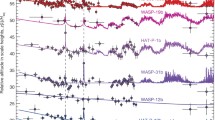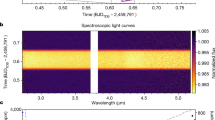Abstract
The wavelength-dependent transit depth indicates the atmosphere composition of an exoplanet. We analyze the transit depth of HATS-5b using the data from the Transiting Exoplanet Survey Satellite (TESS) and compare the radius ratio of the planet to the star with the different band result in previous work. We generate a photometric pipeline to obtain the TESS light curve. The fitting of the HATS-5b light curve derives similar bandpass independent parameters compared to the reference work, e.g., the differences in the inclination and the semi-major axis within 1\(\sigma\). We fix the bandpass-independent parameters to values from the previous work for comparison purposes. The wavelength-dependent \(R_{p}/R_{\ast}\) obtained is 2.5% (1.9\(\sigma\)) smaller compared to the joint band result from the referenced work. The difference of \(R_{p}\)/\(R_{\ast}\) suggests a haze-dominant model preferred by observation (with \(\chi^{2}=1.68\)) when fitting with different atmospheric models. The opaque featureless atmospheric model has a \(\chi^{2}\sim4\), while the other models are ruled out with \(\chi^{2}> 7\). We also predict an \(R_{p}/R_{\ast}\) difference of ∼1\(\%\), correlating the presence of water at \(z\)-band observation. This difference is detectable at 3\(\sigma\) if the photometry precision reaches 500 ppm with 2 minute exposure for one-night observation.






Similar content being viewed by others
Notes
The code for the correction is available: https://github.com/sailoryf/TESS_Deblending/.
References
Birkby, J.L., de Kok, R.J., Brogi, M., de Mooij, E.J.W., Schwarz, H., Albrecht, S., Snellen, I.A.G.: Mon. Not. R. Astron. Soc. 436, L35 (2013)
Bonomo, A.S., et al.: Astron. Astrophys. 602, A107 (2017)
Charbonneau, D., Brown, T.M., Noyes, R.W., Gilliland, R.L.: Astrophys. J. 568, 377 (2002)
Claret, A.: Astron. Astrophys. 618, A20 (2018)
Deming, D., et al.: Publ. Astron. Soc. Pac. 121, 952 (2009)
Deming, D., Seager, S., Richardson, L.J., Harrington, J.: Nature 434, 740 (2005)
Drummond, B., Tremblin, P., Baraffe, I., Amundsen, D.S., Mayne, N.J., Venot, O., Goyal, J.: Astron. Astrophys. 594, A69 (2016)
Gaia Collaboration, et al.: Astron. Astrophys. 616, A1 (2018)
Gibson, N.P., Aigrain, S., Roberts, S., Evans, T.M., Osborne, M., Pont, F.: Mon. Not. R. Astron. Soc. 419, 2683 (2012)
Goyal, J.M., et al.: Mon. Not. R. Astron. Soc. 474, 5158 (2018)
Goyal, J.M., Wakeford, H.R., Mayne, N.J., Lewis, N.K., Drummond, B., Sing, D.K.: Mon. Not. R. Astron. Soc. 482, 4503 (2019)
Hebb, L., et al.: Astrophys. J. 693, 1920 (2009)
Karkoschka, E., Tomasko, M.G.: Icarus 211, 780 (2011)
Kempton, E.M.R., et al.: Publ. Astron. Soc. Pac. 130, 114401 (2018)
Kipping, D.M.: Mon. Not. R. Astron. Soc. 408, 1758 (2010)
Liu, Y.J., et al.: Astrophys. J. 672, 553 (2008)
Madhusudhan, N.: Annu. Rev. Astron. Astrophys. 57, 617 (2019)
Mandel, K., Agol, E.: Astrophys. J. 580, L171 (2002)
Moran, S.E., Hörst, S.M., Batalha, N.E., Lewis, N.K., Wakeford, H.R.: Astron. J. 156, 252 (2018)
Patil, A., Huard, D., Fonnesbeck, C.J.: J. Stat. Softw, 1–81 (2010)
Pollacco, D.L., et al.: Publ. Astron. Soc. Pac. 118, 1407 (2006)
Pont, F., Knutson, H., Gilliland, R.L., Moutou, C., Charbonneau, D.: Mon. Not. R. Astron. Soc. 385, 109 (2008)
Ricker, G.R., et al.: J. Astron. Telesc. Instrum. Syst. 1, 014003 (2015)
Shporer, A., et al.: Astrophys. J. Lett. 890, L7 (2020)
Sing, D.K., et al.: Nature 529, 59 (2016)
Siverd, R.J., et al.: Astrophys. J. 761, 123 (2012)
Smith, J.C., et al.: Publ. Astron. Soc. Pac. 124, 1000 (2012)
Tinetti, G., Deroo, P., Swain, M.R., Griffith, C.A., Vasisht, G., Brown, L.R., Burke, C., McCullough, P.: Astrophys. J. Lett. 712, L139 (2010)
Tremblin, P., Amundsen, D.S., Chabrier, G., Baraffe, I., Drummond, B., Hinkley, S., Mourier, P., Venot, O.: Astrophys. J. Lett. 817, L19 (2016)
Tremblin, P., Amundsen, D.S., Mourier, P., Baraffe, I., Chabrier, G., Drummond, B., Homeier, D., Venot, O.: Astrophys. J. Lett. 804, L17 (2015)
Wang, S., et al.: Astron. J. 157, 51 (2019)
Wang, W., van Boekel, R., Madhusudhan, N., Chen, G., Zhao, G., Henning, T.: Astrophys. J. 770, 70 (2013)
Yang, F., et al.: Astron. J. 161, 294 (2021)
Yang, F., Chary, R.-R., Liu, J.-F.:. arXiv:2012.08744. 2020a, arXiv e-prints
Yang, F., et al.: Astrophys. J. Suppl. Ser. 249, 31 (2020b)
Zhou, G., et al.: Astron. J. 147, 144 (2014)
Acknowledgements
We highly appreciate the constructive comments by the referee. This work utilizes the NASA Exoplanet Archive,Footnote 2 Astroquery,Footnote 3 and the Mikulski Archive for Space Telescopes (MAST). We would like to thank Richard J. Long for the helpful discussion and You-Jun Lu for constructive feedback. Fan Yang, Su-Su Shan, and Ji-Feng Liu acknowledge fundings from the National Key Research and Development Program of China (No. 2016YFA0400800), the National Science Fund for Distinguished Young Scholars (No. 11425313), and the National Natural Science Foundation of China (NSFC. 11988101). X. W. is supported by the National Natural Science Foundation of China (No. 11872246, 12041301) and Beijing Natural Science Foundation (No. 1202015).
Author information
Authors and Affiliations
Additional information
Publisher’s Note
Springer Nature remains neutral with regard to jurisdictional claims in published maps and institutional affiliations.
Rights and permissions
About this article
Cite this article
Yang, F., Shan, SS., Guo, R. et al. Wavelength dependent transit depth of HATS-5b: a haze dominant atmosphere?. Astrophys Space Sci 366, 83 (2021). https://doi.org/10.1007/s10509-021-03989-5
Received:
Accepted:
Published:
DOI: https://doi.org/10.1007/s10509-021-03989-5




